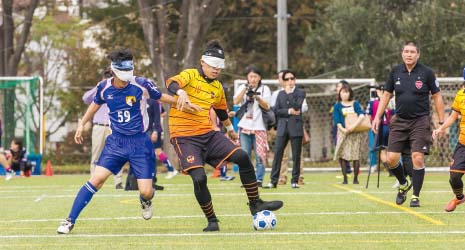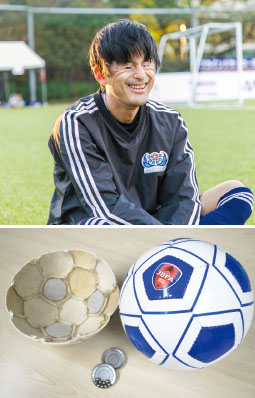Home > Highlighting JAPAN > Highlighting Japan January 2019 > Japanese NPOs Working for Change
Highlighting JAPAN


Surpassing the Limits of Sight Blind Football
In the sport of blind football, both sighted and visually impaired participants play using sound and voices only. A current player and NPO organization speak about their dreams for the sport and about unifying the teams in Japan.
Blind football is a sport traditionally played by five-member teams, set up so players with visual handicaps can be fully engaged in the game. It has become an official sport of the Paralympics, and as the host nation of the 2020 Tokyo Paralympics Japan will naturally have a team of its own. The basic rules are based on those of futsal, but certain aspects have been changed, such as using a ball that rattles and walls at hip height for players to gain a sense of position and the size of the field. When the defending players go after the ball, they also shout “Voy!” (Spanish for “I’ll go”) to alert the other players about where they are.
Eigo Matsuzaki took part in the startup of the NPO Japan Blind Football Association in 2002, and is currently the association’s executive director. He got into blind football when he tried a “pass exchange” in Nara. Matsuzaki realized how easily he could do some things when he could see but was unable to once he was blindfolded, and says he also understood how essential it is to vocalize. It was a moment when a sighted person and a visually impaired person formed a connection.
Blind football cannot be played without the cooperation between the sighted and visually impaired participants. For instance, the goalkeeper—who also instructs teammates—does not wear an eye mask, so players who are sighted or have limited vision take this position. There is also a guide in the back of the opponent’s goal and a coach in the center of the sidelines, both sighted participants allowed to speak.
“Just like we ask tall people to reach for something in a higher place, we hope to create a world where the visually impaired and the sighted can help each other,” Matsuzaki says. “We hope to make this a reality through blind football.” As one of its actions, the association hosted a league match between twenty-one teams consisting of B1 members (a class for the fully blind) with up to two sighted members. Along with the blind, they also have been actively searching for sighted people to join, and have managed to host the Marble Cup tournament twice a year. In addition they have been hosting four to five hundred sports education programs during the year in elementary schools as well as fifty experience programs for adults, called OFF T!ME.
It’s quite normal to put restrictions on sports for the disabled to avoid hard contact and hard landings. However, Tomonari Kuroda, a player on the Tama Hassas team and a member of Japan’s national team since 2002, says: “When we go out into town, we hold a white cane and need to walk cautiously while confirming the safety of our surroundings. On the field, though, we’re able to think freely and run around. The way we can sense real freedom, and how we aim for victory regardless of whether we’re visually impaired or not is very exciting.”
During the match, it’s considered bad manners for spectators to speak, so even during intensive plays the arena is very quiet. When someone scores a goal, however, everyone cheers loudly—that’s part of the fun in blind football. “I’d love to have more people experience and get to know this sport that brings joy to many,” says Matsuzaki.
The 2020 Tokyo Paralympic Games will take place in just two years, and more people around the world will be able to experience this silent but electric type of football. The organization is taking another step closer to an environment in which both the sighted and visually impaired live together naturally, both inside and outside the field.
© 2009 Cabinet Office, Government of Japan







